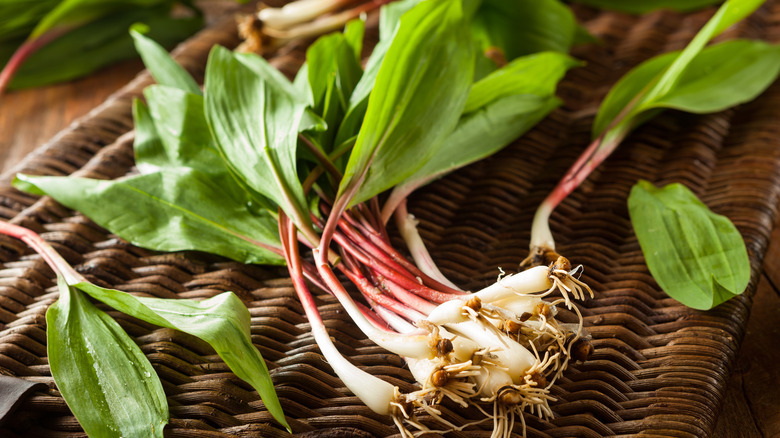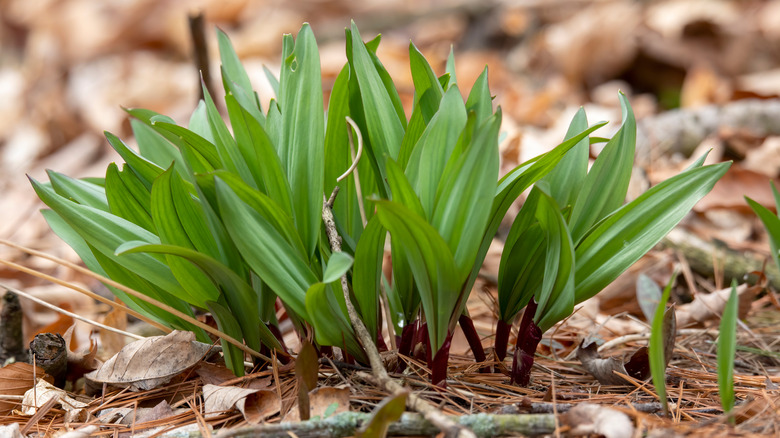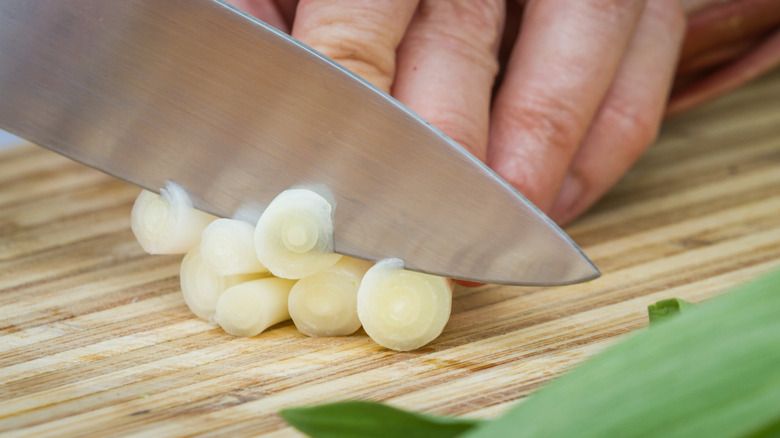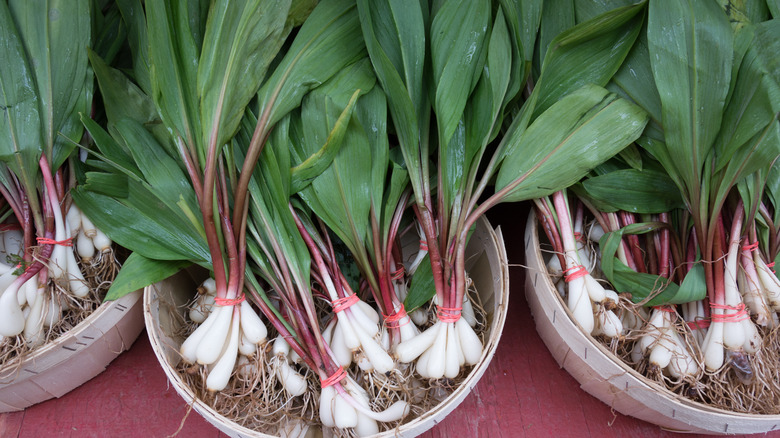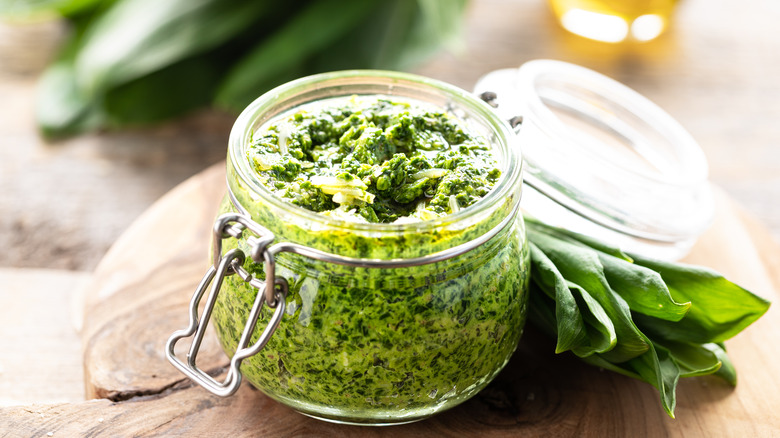Everything You Need To Know About Ramps
Springtime is truly a foodie's dream. It's the time of year so many seasonal delicacies become available, making for a rejuvenated cooking experience. It's when meaty morel mushrooms start peeking through the soil; it's when cutely coiled fiddlehead ferns first pop up (via Farmer's Almanac), and it's also when pungent ramps make their debut.
According to The Spruce Eats, ramps (Allium tricoccum) are one of the first vegetables to emerge after winter, making their appearance a perfect reason to throw a springtime celebration. From Tennessee's Ramp Tramp Festival to West Virginia's Feast of the Ramson and Stink Fest events, the annual arrival of wild ramps is a widely anticipated occurrence fit for fanfare and community festivities. Of course, if you've never had ramps, you might be wondering what exactly they are and how you can get a hold of some. Get ready to get your feet wet – we've put together a launching ramp into the ocean of knowledge on these party-deserving plants!
What are ramps?
Ramps are a wild onion species and look an awful lot like scallions, according to The Spruce Eats. But their leavers are broader, and their stems are purpler. Ramps also share health benefits with all onions. They're an asset to your teeth, bones, eyes, immune and cardiovascular system due to their levels of vitamins A and C, selenium, chromium, and antioxidant properties, according to Farmer's Almanac. One way to pick out a ramp from similar-looking vegetables will have you nosing around.
Ramps have a very specific smell. The Meat Eater describes that smell as "pungent and sweet" and "similar to onion, but not quite." One token of advice to keep in mind from Visit West Virginia is: "If you can't smell it, that probably means it isn't a ramp!" The good news is, identifying the ramp aroma may be similar to riding a bike. According to The Meat Eater, after you get the hang of recognizing the aroma, it's hard to forget.
Interestingly, this odorous wild onion may have gotten its name from another plant in the Allium genus, the wild garlic plant. The Spruce Eats credits "The Encyclopedia of American Food & Drink" author John Mariani with explaining that the name "ramps" originated with "rams" or "ramson," which were names given to the wild garlic plant in Elizabethan dialect. But, ramps go by other names as well. According to Eater, they are sometimes called wild leeks or spring onions. It seems a ramp by any other name, would still smell as strong!
What part of ramps do you eat and what do they taste like?
If you're someone who feels a twinge of guilt while discarding the unused scraps of your vegetables, then using ramps may bring you some comfort. According to Real Simple, you can consume pretty much any part of a ramp. The only part you should probably toss in the trash, according to the site, is the roots after you've cut them from the end of the bulb.
When it comes to eating them, ramps have an onion-garlicky flavor according to the Food Network website, and all that tangy taste packed in organically makes them a versatile ingredient that doesn't require a lot of preparation (but, may require an acquired taste). Real Simple points out that raw ramps can also be eaten if you're into their bold flavor, but sauteing them will achieve a less concentrated flavor. Another way to try ramps in the raw is by soaking them.
Chef and Owner of Daisies in Chicago, Joe Frillman, does exactly that. "We like to macerate them into vinaigrettes, marinades, condiments," Frillman told Food & Wine. The chef elaborated on the purpose behind his ramp strategy: "Sliced vibrant citrus with a raw ramp vinaigrette lets you savor the pungency but also wakes you up from the flavor punch they bring to the table."
Where do ramps grow and how can you buy them?
Ramps have a short season. According to Epicurious, it's over in under three weeks, so if you're interested in obtaining some for your own cooking experiments, you only have a brief window of opportunity. To really get on board the ramp train, you may want to head to the woodlands of the Appalachian region. According to The Spruce Eats, harvesting ramps begins there in mid-March, and several states in the region hold ramp festivals where you can try ramp dishes. Chickens in the Road points out you can even buy them in Appalachia at roadside stands.
Ramps also pop up around the Great Lakes towards the beginning of April. If you plan on foraging for ramps, then The Meat Eater recommends looking for woodlands with "partial shade, streambanks, riparian zones, and ravines" as well as "hardwood forests with rich, moist, well-drained soil." The site cautions that there are some poisonous doppelgangers out there, so using ample caution and research is necessary.
If you're not from Appalachia or the Great Lakes, another place closer to home to find ramps is your local farmer's market. Just be sure to bring enough cash! According to Larder Delicatessen & Bakery, ramps can run for a staggering $20 a pound! You should look for non-wilted, dark green specimens that do not have any see-through areas. You'll also want to choose ramps with long, thin stalks between 10 and 14 inches long. Then, it's time to ramp up the kitchen.
How to cook with ramps
If you've had ramps before, found them appetizing, and are looking for a simple way to prepare them, Cooking Channel TV has a list of suggested recipes, including grilling or sauteing them and tossing them with olive oil, salt, and pepper. In Appalachia, ramps are "most traditionally served fried in bacon fat with eggs and/or potatoes and served with pinto beans and cornbread," according to Chickens in the Road. Another recipe straight out of Visit West Virginia shows you how to preserve your prized spring delicacies, by turning them into ramp butter that can be refrigerated or frozen to be used at a later date as a spread or in a sauce.
If you're new to cooking with ramps (and tasting them), Food Network recommends starting with a familiar dish, like pesto. You can use the website's Basil Pesto recipe as a starting board and swap in a cup of chopped ramps, including the leaves and stems, for a cup of basil. The result is more flavorful but shouldn't be overwhelming since it has recognizable tasting notes.
However, if you're really looking to serve up spring on a platter, check out Emeril Lagasse's recipe for Pacific Coast Salmon and Wild Ramps, with a Morel, Crawfish, and Fiddlehead Fern Ragout on the Food Network website. You might have to go foraging (or Googling!) to find all the ingredients, but from the looks of it, your guests will find it well worth your effort!
